
Biggest Golf Myth for Beginners
Biggest Golf Myth for Beginners
Shattering the "Biggest Golf Myth for Beginners": Why Keeping Your Head Down Isn't the Answer
As a newcomer to golf, you’re likely to encounter a variety of advice, but not all of it is beneficial. Today at Golf For Beginners Academy, we’re tackling what might be the “Biggest Golf Myth for Beginners”: the often-repeated advice to “keep your head down” during your golf swing. I’m Nicolai, and I’m here to guide you through why this well-meaning advice could be detrimental to your game.
The Myth: Keep Your Head Down
It’s a phrase every beginner golfer has heard: “Keep your head down after you hit the ball.” This advice, intended to improve your swing, is actually at the core of the “Biggest Golf Myth for Beginners.” However, rigidly following this tip can lead to a host of problems in your swing mechanics.
Understanding Golf Swing Dynamics
Contrary to the “Biggest Golf Myth for Beginners,” a successful golf swing is about fluid motion and balance, not rigidity. The belief that one must keep their head down limits the natural flow of the body. Let’s explore why this is counterproductive:
The Correct Swing Mechanics

Understanding the right way to swing is crucial in overcoming the “Biggest Golf Myth for Beginners.” Professional golfers exemplify a different approach: allowing the head to move up and follow the ball after impact. This movement is essential for full body rotation and extension.
The Problem with Locking Your Head Down
Restricted Body Rotation: Keeping your head down hampers the full rotation of your shoulders and hips, essential components of a powerful swing.
Limited Extension: A static head position restricts the natural extension of your arms and body, leading to a cramped and ineffective swing.
Impeded Follow-Through: The follow-through is crucial for the direction and distance of your shot. A locked head position prevents a full, smooth follow-through.
The Revised Phrase: Keeping Your Head Steady
A more appropriate phrase that should replace “keep your head down” is “keep your head from moving up and down, or from side to side.” This nuanced understanding is crucial for several reasons:
Lateral Stability:
- Avoiding Side-to-Side Movement: Excessive lateral movement of the head can throw off your balance and timing. Keeping your head from moving side to side helps maintain alignment and ensures a consistent swing path.
Vertical Stability:
- Preventing Up and Down Movement: While some vertical movement is natural, too much can lead to a change in your body’s position relative to the ball. This can result in inconsistent contact and erratic shots.
Implementing the Correct Head Movement
To practice this refined approach, here are some tips:
Focus on a Spot: Instead of fixating on the ball, pick a spot on the ground near the ball to focus on. This helps in maintaining a steady head without the stiffness associated with staring directly at the ball.
Feel the Swing’s Flow: As you swing, be mindful of your head’s movement. It should feel natural and in sync with the rest of your body, not disconnected or overly rigid.
Record and Review: If possible, record your swing. This allows you to visually confirm if your head is moving excessively and adjust accordingly.
Want to learn more about the backswing? 
Ready to Take the Next Step? ⛳️
If you’re eager to dive deeper into golf’s intriguing world and master the ins and outs of the game, look no further than our “Golf For Beginners – The Ultimate Starter Guide.” Whether you’re a newbie or just brushing up on your skills, this online course has something for everyone.
⛳️ Discover the Ultimate Golf Starter Guide Right Here ⛳️
Conclusion: Your Journey to Golf Mastery
Congratulations! You’ve navigated through our comprehensive guide on golf tips for beginners. Remember, mastering golf is a continuous journey of improvement. Apply these tips, stay dedicated to your practice, and enjoy the evolving experience of becoming a skilled and confident golfer. Golf For Beginners Academy is here to support you every step of the way. Happy golfing!
If you are interested in understanding the Short Game of golf into very specific details, we strongly recommend that you check out World Of Short Game.
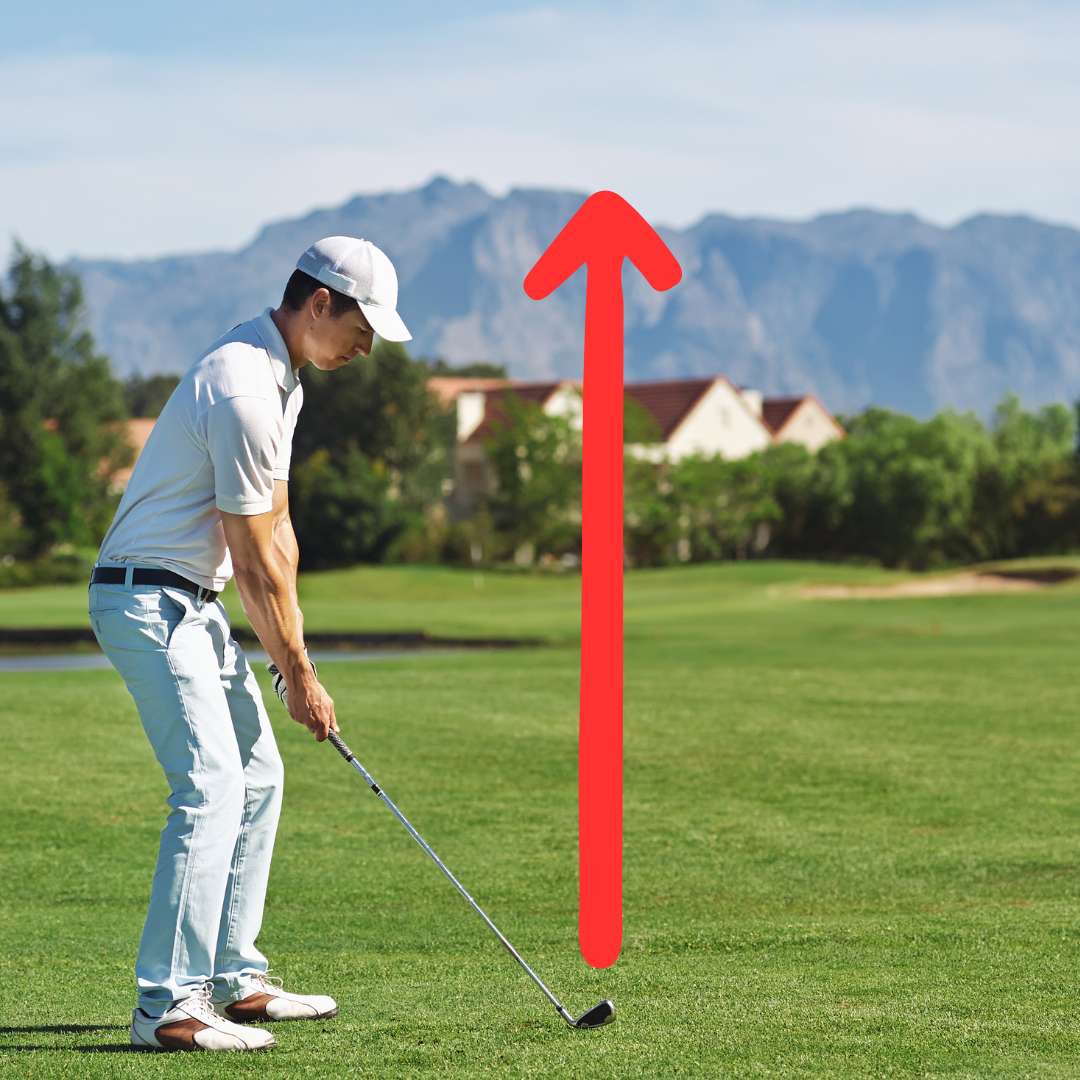
How to Hit a Golf Ball Straight for Beginners
How to Hit a Golf Ball Straight for Beginners
Introduction to How To Hit Straight Golf Balls for Beginners
Are you a beginner golfer, and want to know How to Hit a Golf Ball Straight for Beginners? Whether your ball veers too much to the right or to the left, there’s a simple and quick fix. Nicolai, our expert golf instructor at Golf For Beginners Academy, unveils an easy solution to this common beginner’s challenge.
The Common Challenge for Beginners
One of the most frequent issues new golfers face is controlling the direction of their golf ball. It can be frustrating when your shots consistently go off course. But don’t worry, the key to solving this isn’t as complex as you might think.

The Importance of the Grip in Golf

The way you grip your golf club plays a pivotal role in determining the ball’s flight path. A proper grip can be the difference between a straight shot and one that strays off course. For right-handed players, this often means adopting what’s known as a ‘stronger grip.’
Step-by-Step Guide: Correcting a Rightward Shot
If your shots are veering to the right, here’s a simple adjustment you can make:
Position the Club: Ensure the club is behind the ball, aiming straight.
Adjust Your Grip: Rotate both hands towards the right side of the grip. This is your stronger grip.
Understand the Effect: This grip change will naturally cause your hands to return to a more neutral position during the swing, closing the club face and correcting the rightward drift.
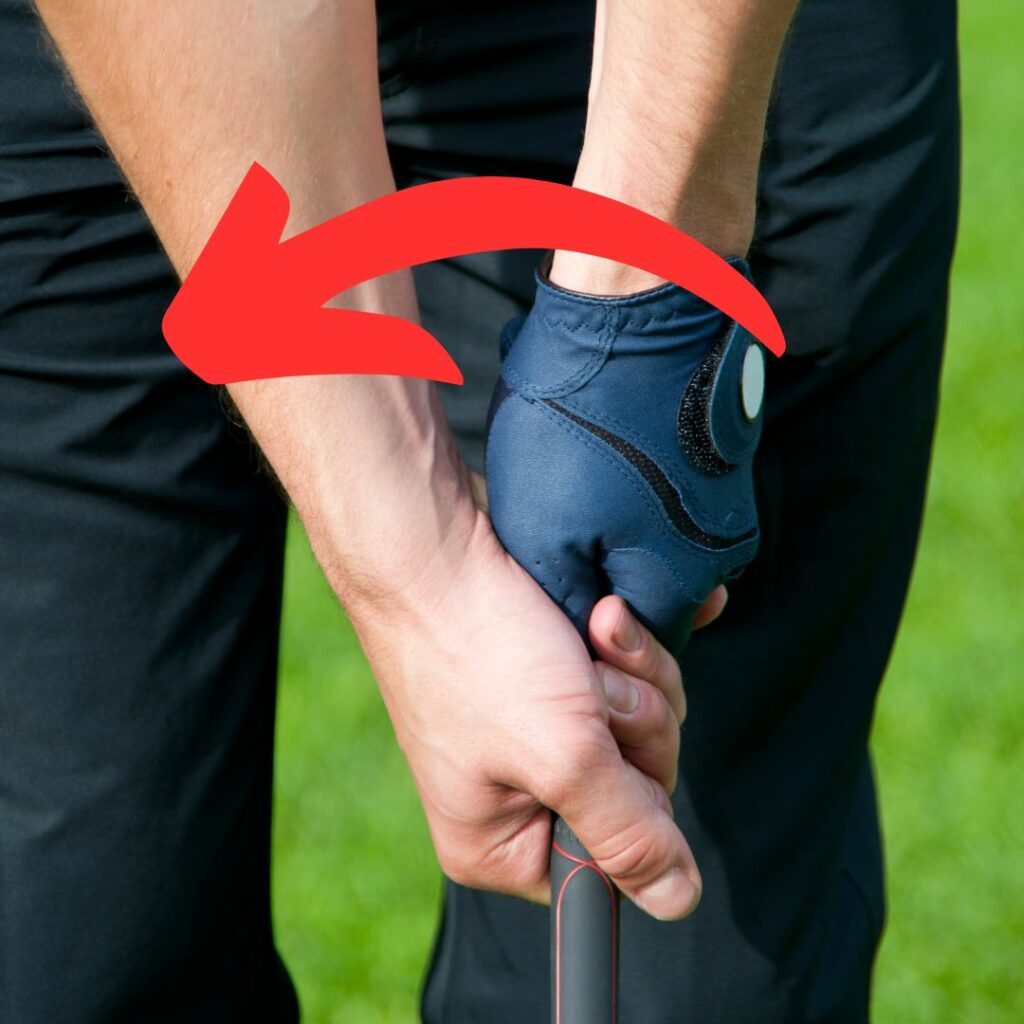
Step-by-Step Guide: Correcting a Leftward Shot
For shots going too much to the left, the approach is slightly different:

Club Face Positioning: Start with the club face straight behind the ball.
Grip Adjustment: Move your hands towards the left side of the grip.
Expected Outcome: This grip will tend to open the club face during the swing, countering the leftward tendency of your shots.
Practical Application and Tips
Practice these grip adjustments to find the right balance for your swing. Remember, the goal is to make subtle changes to the grip. Over-exaggeration can lead to opposite issues.
Ready to Take the Next Step? ⛳️
If you’re eager to dive deeper into golf’s intriguing world and master the ins and outs of the game, look no further than our “Golf For Beginners – The Ultimate Starter Guide.” Whether you’re a newbie or just brushing up on your skills, this online course has something for everyone.
⛳️ Discover the Ultimate Golf Starter Guide Right Here ⛳️
Conclusion to How to Hit a Golf Ball Straight for Beginners
Mastering the art of a straight golf shot is a fundamental skill for every beginner. By tweaking your grip, you can see immediate improvements in your game. For more insightful tips and golfing guidance, subscribe to our YouTube channel and visit Golf For Beginners Academy. Dive into our range of articles and resources tailored for your golfing journey. Thank you for reading, and here’s to improving your game, one shot at a time!
Did you like How to Hit a Golf Ball Straight for Beginners
If you want more detailed help with you game of golf, and specifically about the short game of golf, our partner-portal called World Of Short Game deliver great content for all short game related topics. Click here to visit World Of Short Game.
And if you live in Denmark, never hesitated to reach out to Danish Golf Academy for help with any part of your game.

8 Essential Tips on How to Swing a Golf Club for Beginners
How to Swing a Golf Club for Beginners
8 Essential Tips for How to Swing a Golf Club for Beginners
Embarking on your golf journey? The golf swing, often considered an art form, lays the groundwork for your success on the course. In this comprehensive guide, we’ll delve into eight essential tips on how to swing a golf club for beginners. Drawing inspiration from proven techniques, these detailed insights aim to guide you through the fundamental aspects, ensuring a confident and effective swing every time you step onto the course.
1. Solidify Your Setup
Lay the foundation for a successful swing with a proper setup. Ensure your feet are shoulder-width apart, parallel to the target line. Align the clubface square to the target and distribute your body weight evenly. Position the ball just inside your lead heel for a consistent and centered contact point.
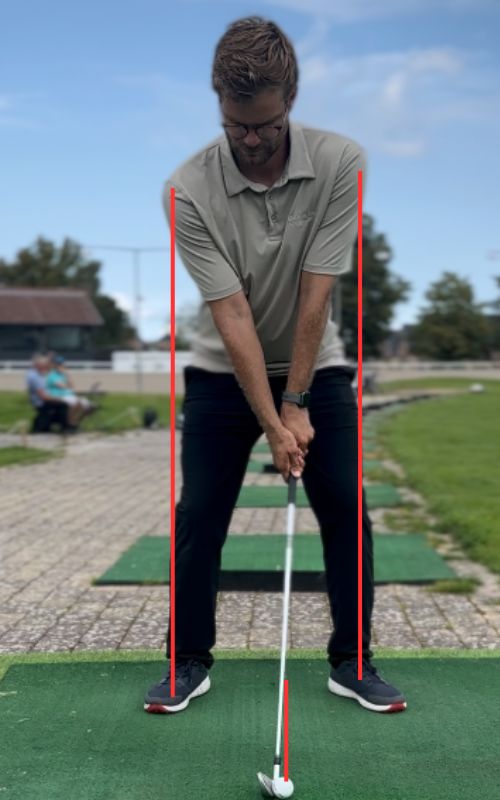
Want to dive deeper into the perfect setup? Listen to our Podcast:
2. Grip with Confidence
Find a grip that feels secure and comfortable. Whether you choose an overlapping, interlocking, or ten-finger grip, prioritize a unified connection between your hands. Pay attention to grip pressure, aiming for a neutral grip that strikes the right balance between control and flexibility.
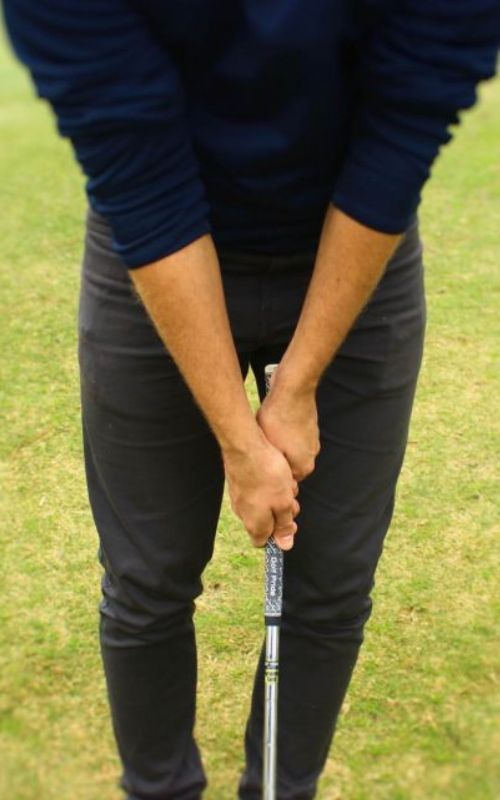
3. Initiate a Controlled Takeaway
Start your backswing with a smooth and controlled takeaway. Keep the club low to the ground during the initial phase, fostering a gradual build-up of power. Visualize the club sweeping away from the ball with precision, setting the stage for a consistent and efficient backswing.
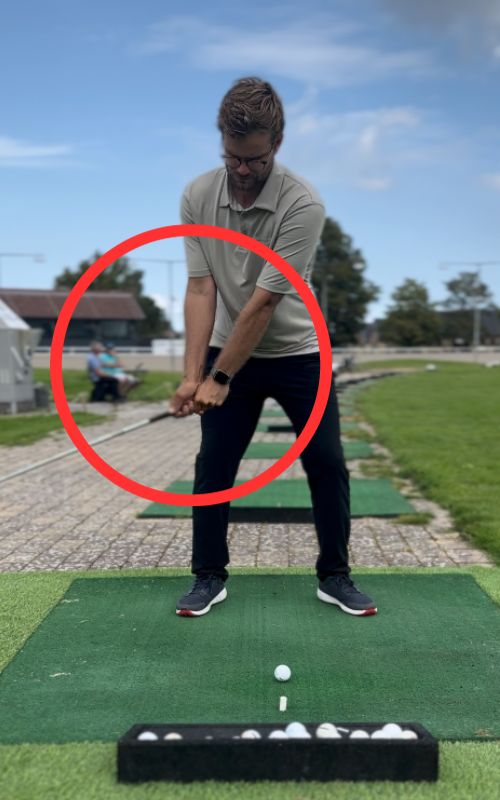
4. Maximize Power through Rotation
Achieve maximum power by focusing on a complete body rotation. Ensure your shoulders turn fully while maintaining stability in your lower body. This proper rotation generates torque, allowing you to unleash stored energy into the downswing.

5. Cultivate Lag for Impact
Transition from backswing to downswing by cultivating lag in your wrists. Retain this angle until the last moment, then release it explosively through impact. This sequence ensures a whip-like effect, translating into increased clubhead speed and distance.
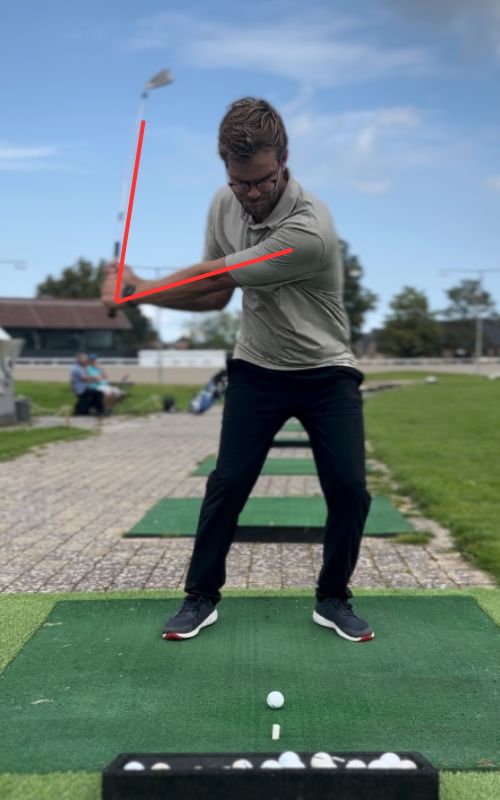
6. Keep a Steady Head
Enhance your balance and consistency by keeping your head steady throughout the swing. A stable head acts as an anchor, providing better control over your body’s movements. Fixate on a point just behind the ball, avoiding unnecessary lateral or vertical head movements.
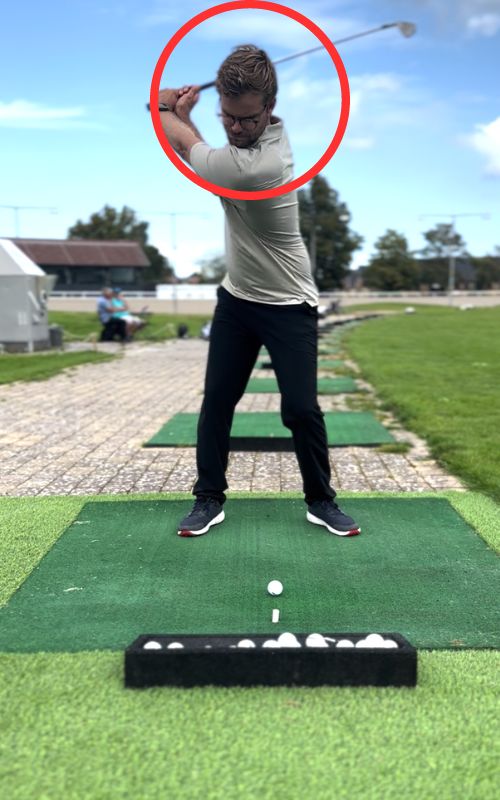
7. Complete Your Swing with Confidence
Conclude your swing with a confident and balanced follow-through. Allow your body to naturally follow the motion, with your belt buckle facing the target. Hold the finish position until the ball lands, promoting stability and indicating a well-executed swing.
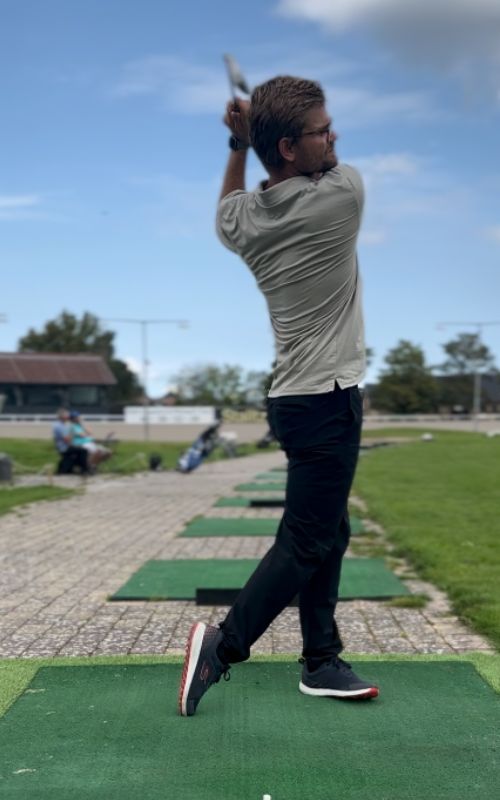
8. Embrace a Continuous Learning Journey towards How to Swing a Golf Club for Beginners
Recognize that mastering the golf swing is an ongoing process. Embrace a mindset of continuous learning and improvement. Regularly assess and refine your technique, seek guidance from experienced golfers, and remain patient as you progress on your journey to becoming a confident and skilled golfer
Ready to Take the Next Step? ⛳️
If you’re eager to dive deeper into golf’s intriguing world and master the ins and outs of the game, look no further than our “Golf For Beginners – The Ultimate Starter Guide.” Whether you’re a newbie or just brushing up on your skills, this online course has something for everyone.
⛳️ Discover the Ultimate Golf Starter Guide Right Here ⛳️
Conclusion on How to Swing a Golf Club for Beginners
Congratulations! You’ve now explored eight essential tips on how to swing a golf club for beginners. Integrate these insights into your practice routine, focus on refining your technique, and witness the improvement in your swing. Happy golfing!
If you want more detailed help with you game of golf, and specifically about the short game of golf, our partner-portal called World Of Short Game deliver great content for all short game related topics. Click here to visit World Of Short Game.
And if you live in Denmark, never hesitated to reach out to Danish Golf Academy for help with any part of your game.

Which golf club to use?
Which golf club to use?
A Comprehensive Guide on Which Golf Club to Use
Embarking on your golf journey? Understanding the purpose of each golf club is fundamental for success on the course. In this detailed guide, we’ll delve into the intricacies of different golf clubs, their designs, and when to strategically use them. Welcome to Golf For Beginners Academy’s exploration of “Which golf club to use?”
The Mighty Driver
The driver, a club designed for maximum distance, plays a pivotal role in setting the stage for a successful hole.
Purpose of the Driver: The driver is primarily used for tee shots on par-4s and par-5s, providing the maximum distance off the tee.
Clubhead Design: Recognizable by its oversized clubhead, the driver’s large sweet spot enhances forgiveness, allowing for more distance even on off-center hits.
When to Use: Opt for the driver on long and open holes where distance is crucial. Tee shots on par-4s and par-5s are ideal scenarios for unleashing the power of the driver.

Navigating Fairway-Woods
Fairway-woods serve as versatile clubs designed for both distance and control, offering alternatives to the driver
Purpose of Fairway-Woods: Fairway-woods are designed for long shots from the fairway, providing a balance between distance and accuracy.
Clubhead Design: With a shallower profile than the driver, fairway-woods have a lower center of gravity, promoting a higher launch trajectory.
When to Use: Opt for fairway-woods when faced with long shots from the fairway, or when needing to navigate through challenging fairway or rough terrain.
The Versatility of Hybrids
Hybrids blend the characteristics of irons and fairway-woods, offering forgiveness and ease of use.
Purpose of Hybrids: Hybrids are versatile clubs designed to replace difficult-to-hit long irons. They provide a combination of distance, accuracy, and playability.
Clubhead Design: With a design resembling both irons and fairway-woods, hybrids typically feature a larger clubhead and a lower center of gravity.
When to Use: Utilize hybrids in situations where a balance of distance and control is required, especially in scenarios where long irons might pose challenges.

The Backbone of the Bag - Irons
Irons, numbered from 3 to 9, are designed to cover a range of distances and play a crucial role in approaching the green.

Purpose of Irons: Irons are used for approach shots, providing precision and control to land the ball on the green.
Clubhead Design: Irons have a thinner profile compared to woods, with clubheads featuring varying degrees of loft for different distances.
When to Use: Choose irons based on the required distance for approach shots. Lower-numbered irons (3-5) are ideal for longer shots, while higher-numbered irons (6-9) are suitable for shorter approaches.
Wedges - Precision in Scoring
Wedges, including the pitching wedge, gap wedge, sand wedge, and lob wedge, are specialized for short-distance shots around the green.
Purpose of Wedges: Wedges are designed for precise control over short shots, including pitches, chips, and bunker play.
Clubhead Design: Wedges have a high loft, allowing for a steeper angle of descent and greater spin control.
When to Use: Employ wedges for shots within 120 yards of the green, as well as when faced with challenging lies, bunkers, or the need for precise control.

Putting - The Art of the Putter
The putter, the final touch in completing each hole, is designed for precision and control on the greens.

Purpose of the Putter: The putter is used on the green for short and controlled strokes to roll the ball into the cup.
Clubhead Design: Putters have a flat, low-profile clubhead with various designs to suit different putting preferences.
When to Use: Use the putter on the green to complete the hole. It is essential for precision in short-range putts.
Want to learn even more? Listen to our Podcast!⛳️
Ready to Take the Next Step? ⛳️
Are you eager to dive deeper into golf’s intriguing world and master the ins and outs of the game? Look no further than our “Golf For Beginners – The Ultimate Starter Guide.” Whether you’re a newbie or just brushing up on your skills, this online course has something for everyone.

Conclusion on Which golf club to use
Congratulations! You’ve navigated through our comprehensive guide on “Which golf club to use?” As you continue your golf journey, remember that each club in your bag has a specific purpose. Golf For Beginners Academy is here to support you every step of the way. Tailor your club selection to the demands of the course, refine your skills, and enjoy the versatility and precision each club brings to your game. Happy swinging!
Du you want more detailed help with you game of golf, and specifically about the short game of golf? Our partner-portal called World Of Short Game deliver great content for all short game related topics. Click here to visit World Of Short Game.
And if you live in Denmark, never hesitated to reach out to Danish Golf Academy for help with any part of your game.

Golf Swing for Beginners – A Comprehensive Guide
Golf Swing for Beginners
A Comprehensive Guide to Master the Golf Swing For Beginners
Embarking on your golf journey? Perfecting your golf swing is fundamental, especially for beginners. In this guide, we’ll explore the intricacies of the golf swing, drawing inspiration from principles that enhance balance and consistency. Let’s break it down into crucial components, from the setup to the follow-through, ensuring you build a solid foundation for your swing.
Setup for Success
Proper Alignment: Ensure your feet, hips, and shoulders are parallel to the target line. This alignment sets the stage for a consistent and accurate swing.
Weight Distribution: Embrace a forward weight principle. Shift your weight towards the lead foot, maintaining about 55-60% of your weight on that side for better control.
Ball Position: Place the ball slightly forward in your stance, opposite the lead heel. This encourages a sweeping motion through impact.
Arm Position: Keep your arms relaxed and extended. A slight bend in your elbows promotes a wide takeaway, contributing to a more powerful swing.

Building a Solid Backswing

Connected Takeaway: Initiate your backswing by moving your entire body together. Emphasize a connected, one-piece takeaway.
Maintaining Spine Angle: Resist the urge to lift your upper body excessively. Keep your spine angle constant to promote a consistent and repeatable swing.
Full Shoulder Turn: Rotate your shoulders fully to achieve a complete backswing. This turn sets the stage for generating power on the downswing.
Lead Arm Depth: Focus on maintaining depth with your lead arm. Keep the lead arm close to the chest, promoting a compact and controlled backswing.
Executing the Downswing
Weight Transfer: Emphasize a lateral shift of your weight towards the lead foot. This forward weight transfer maximizes the power and consistency of your downswing.
Hip Rotation: Initiate your downswing with a rotation of the hips. This movement creates a dynamic sequence, transferring energy from the lower body to the upper body.
Maintaining Spine Tilt: Keep the spine tilted away from the target as you initiate the downswing. This maintains the inside-out swing path crucial for accuracy.
Dynamic Release: Allow for a natural release of the clubhead through impact. Promote a full extension of the arms for a powerful and controlled strike.

Picture-Perfect Follow-Through

Full Extension: Aim for a full extension of the arms post-impact. This extension maximizes clubhead speed and contributes to a fluid follow-through.
Right Heel Lift: Experience a lift of the right heel (for a right-handed player) during the follow-through. Facilitate a complete rotation of the body for a balanced finish.
Posture Maintenance: Maintain a balanced and athletic posture as you complete your swing. A controlled finish reflects the overall stability and control of your swing.
Head Position: Keep your head steady and facing the target throughout the follow-through. Stability promotes consistency and accuracy in your shots.
Want a deeper understadning of the golf swing? ⛳️
Ready to Take the Next Step? ⛳️
If you’re eager to dive deeper into golf’s intriguing world and master the ins and outs of the game, look no further than our “Golf For Beginners – The Ultimate Starter Guide.” Whether you’re a newbie or just brushing up on your skills, this online course has something for everyone.
⛳️ Discover the Ultimate Golf Starter Guide Right Here ⛳️
Your Journey to a Perfected Golf Swing
Congratulations! You’ve navigated through our comprehensive guide to the golf swing for beginners, inspired by principles that enhance balance and consistency. As you practice these principles, remember that mastery comes with consistent effort and dedication. Golf For Beginners Academy is here to support you every step of the way. Embrace these principles, refine your swing, and enjoy the journey to becoming a skilled and confident golfer. Happy swinging!
If you want more detailed help with you game of golf, and specifically about the short game of golf, our partner-portal called World Of Short Game deliver great content for all short game related topics. Click here to visit World Of Short Game.
And if you live in Denmark, never hesitated to reach out to Danish Golf Academy for help with any part of your game.

How to Hold a Golf Club for Beginners – 5 Easy Steps
How to Hold a Golf Club for Beginners
5 Easy Steps to Mastering the Golf Grip Once and for All!
How to Hold a Golf Club for Beginners forms the foundation for a successful golfing journey, and for every golf swing. In this guide, we’ll explore the five most crucial aspects of gripping a golf club for beginners. Whether you’re new to the game or looking to refine your grip, these detailed tips will set you on the path to a more controlled and confident swing.
Step 1: The Basics of the Interlocking Grip
Begin by placing your lead hand (left hand for right-handed golfers, right hand for left-handed golfers) on the club’s handle. Position the grip diagonally across the base of your fingers, creating a V-shaped gap between your thumb and forefinger. Insert the pinkie finger of your lead hand into the space between the index and middle fingers of your trail hand. This interlocking grip promotes a unified hold and enhances control.
Step 2: Proper Placement of the Hands
Achieving the correct placement of your hands is paramount when you are learning how to hold a golf club for beginners, for both control and precision reasons. The grip should run diagonally across the fingers of your lead hand, with the handle resting just beneath the heel pad. Ensure that your trail hand complements the lead hand, forming a cohesive connection. The lifeline of your trail hand should align with the thumb of your lead hand. This harmonious hand placement fosters a comfortable and secure grip.

Step 3: Maintain a Neutral Grip Pressure
Finding the right balance of grip pressure is crucial for control and flexibility. Aim for a neutral grip pressure, where you firmly hold the club without excessive tension. On a scale of 1 to 10, with 1 being the lightest and 10 the tightest, aim for a grip pressure of around 5. This allows for freedom in your wrists during the swing and enhances overall feel and responsiveness.
Step 4: Align the Clubface Squarely
When learning how to hold a golf club for beginners, achieving a square clubface at address is vital for accurate ball striking. Ensure that the leading edge of the clubface is perpendicular to the target line. The back of your lead hand (left hand for right-handed golfers, right hand for left-handed golfers) should align with the clubface. This square alignment sets the foundation for consistent shots and minimizes the risk of slices or hooks.
Step 5: Consider Your Finger Positions
Pay attention to the positioning of your fingers to optimize grip stability. The fingers of your lead hand should securely wrap around the grip, with the fingertips making contact. The trail hand’s fingers should wrap around the lead hand’s fingers, ensuring a secure connection. Avoid letting the club rest too much in the palm of your hands, as this may lead to a less stable grip.
Ready to Take the Next Step? ⛳️
If you’re eager to dive deeper into golf’s intriguing world and master the ins and outs of the game, look no further than our “Golf For Beginners – The Ultimate Starter Guide.” Whether you’re a newbie or just brushing up on your skills, this online course has something for everyone.
⛳️ Discover the Ultimate Golf Starter Guide Right Here ⛳️
Conclusion on How to Hold a Golf Club for Beginners
Congratulations! You’ve explored the five most important aspects of holding a golf club for beginners. Consistent practice and mindful application of these gripping techniques will undoubtedly enhance your control and confidence on the course. Golf For Beginners Academy is here to support you on your journey to mastering the art of the golf grip. Incorporate these tips into your practice routine, focus on refining your hold, and experience the improvement in your overall swing. Grip it right and swing with confidence!
If you want more detailed help with you game of golf, and specifically about the short game of golf, our partner-portal called World Of Short Game deliver great content for all short game related topics. Click here to visit World Of Short Game.
And if you live in Denmark, never hesitated to reach out to Danish Golf Academy for help with any part of your game.

Golf Driving Tips for Beginners
7 Comprehensive Golf Driving Tips for Beginners
From Driving Beginner to Expert with 7 Golf Driving Tips for Beginners
Mastering the art of driving is a pivotal skill that can elevate your game. We’ll explore the seven best golf driving tips designed specifically for beginners. Whether you’re teeing off for the first time or looking to enhance your driving prowess, these detailed tips will set you on the path to more accurate and powerful drives.
1. Perfect Your Setup
A successful drive begins with a proper setup. Ensure your feet are shoulder-width apart, allowing for stability and balance. Tee the ball at a height where its equator aligns with the top of the driver’s face. Position the ball toward your front foot to encourage an upward strike. Lastly, slightly tilt your spine away from the target, promoting an inside-to-outside swing path.
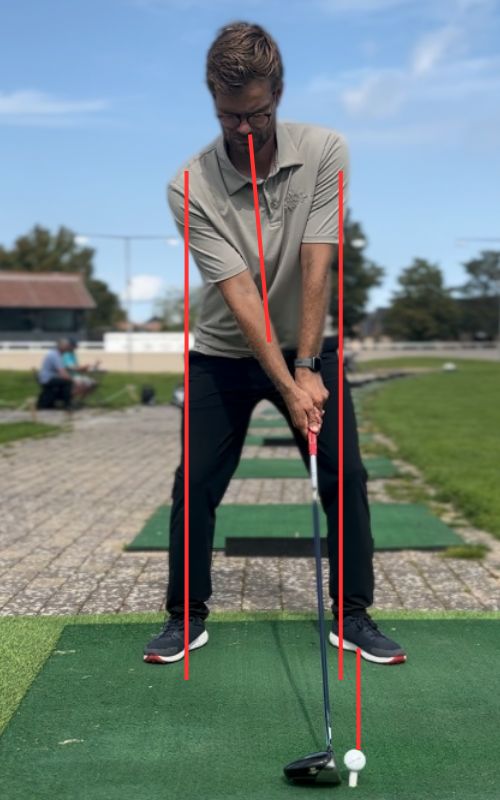
You can also listen to this article on Podcast!
2. Grip It Right
Achieving the correct grip is crucial for control and power. Opt for a neutral grip, where the “V” formed by your thumb and forefinger points toward your trailing shoulder. Maintain a firm yet relaxed grip pressure, allowing for freedom in your wrists during the swing. Practice the grip to find the right balance that feels comfortable and secure.

3. Embrace the Waggle
Incorporate a pre-shot waggle to relieve tension and set the rhythm for your swing. The waggle involves small, rhythmic motions that mimic the upcoming swing. It helps you feel connected to the club, promotes relaxation, and enhances your overall swing fluidity. Experiment with the waggle until you find a motion that feels natural to you.
4. Focus on a Smooth Takeaway
Initiate your backswing with a smooth and controlled takeaway. Keep the clubhead low to the ground during the initial phase, allowing for a gradual build-up of power. Avoid abrupt movements or lifting the club too quickly. Visualize sweeping the clubhead away from the ball with precision, fostering a consistent and efficient backswing
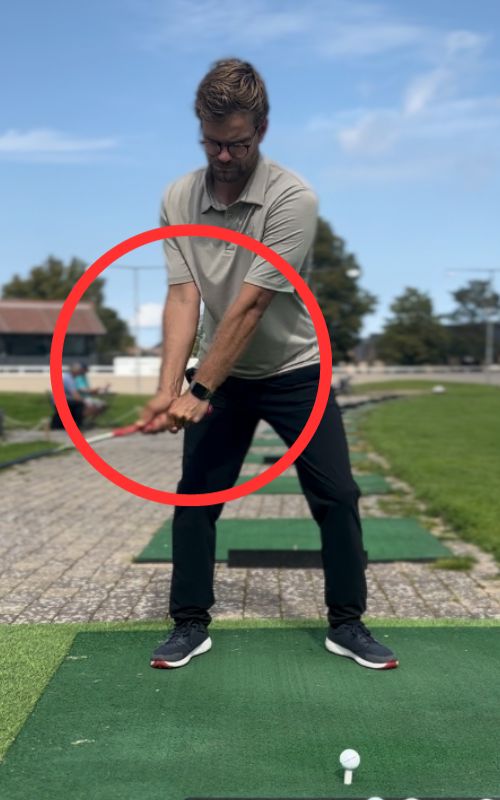
5. Harness the Power of Rotation
Maximize your driving distance by incorporating a proper body rotation. As you reach the top of your backswing, ensure your shoulders have turned fully to 90 degrees. The correct rotation generates torque, unleashing stored energy into the downswing. Practice this motion to strike a balance between upper and lower body rotation.
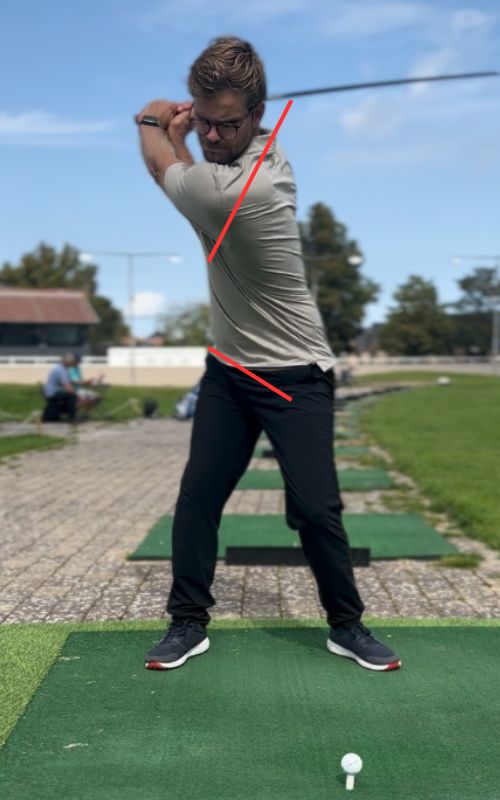
6. Create Lag for Explosive Impact - A Difficult but Powerfull Golf Driving Tips for Beginners
To optimize power, focus on creating lag in your downswing. Lag refers to the angle formed between your wrists and the clubshaft as you transition from backswing to downswing. Retain this angle until the last moment, then release it explosively through impact. This sequence ensures a whip-like effect, translating into increased clubhead speed and distance.

7. Finish Strong with Balance
The importance of a balanced finish cannot be overstated. After impact, allow your body to naturally follow through, with your belt buckle facing the target. Hold the finish position until the ball lands. A balanced finish not only enhances accuracy but also indicates a well-executed swing. Focus on stability and avoid any excessive weight shifts during and after impact.
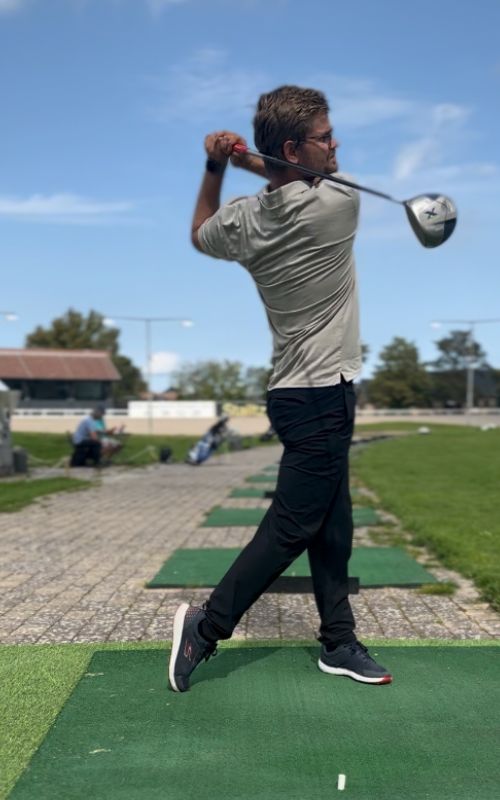
Ready to Take the Next Step? ⛳️
If you’re eager to dive deeper into golf’s intriguing world and master the ins and outs of the game, look no further than our “Golf For Beginners – The Ultimate Starter Guide.” Whether you’re a newbie or just brushing up on your skills, this online course has something for everyone.
⛳️ Discover the Ultimate Golf Starter Guide Right Here ⛳️
Conclusion in the Best Golf Driving Tips for Beginners
Congratulations! You’ve delved into the seven comprehensive golf driving tips for beginners. Consistent practice and mindful application of these tips will undoubtedly enhance your driving skills. Golf For Beginners Academy is here to support you on your journey to becoming a confident and skilled driver. Integrate these tips into your practice routine, focus on refining your technique, and witness the improvement in your driving game. Happy teeing!
Did you like "Golf Driving Tips for Beginners" and want more free help?
If you want more detailed help with you game of golf, and specifically about the short game of golf, our partner-portal called World Of Short Game deliver great content for all short game related topics. Click here to visit World Of Short Game.
And if you live in Denmark, never hesitated to reach out to Danish Golf Academy for help with any part of your game.

Top 10 Golf Swing Tips for Beginners
Top 10 Golf Swing Tips for Beginners
Mastering the Basics of The Golf Swing with these 10 Best Beginners Tips
Embarking on your golf journey? Mastering the golf swing is a crucial aspect of improving your game. In this comprehensive guide, we’ll delve deeper into the top 10 golf swing tips tailored for beginners. Whether you’re stepping onto the course for the first time or refining your skills, these in-depth tips are designed to set you on the path to a more controlled and powerful golf swing. You can also find this article as a podcast episode in the bottom of the page 🙂
1. Hit the Ground After the Ball:
Ensure a proper ball-turf contact by focusing on hitting the ground slightly after striking the ball. This tip encourages a descending strike, allowing the clubhead to make clean contact with the ball before the turf. Practice this by focusing on a spot just beyond the ball during your setup, promoting a downward motion through impact.

Want to listen to this article via Podcast? 
2. Keep Your Weight Forward (probably the most important tips in the golf swing for beginners!)
Maintain a forward weight distribution throughout your swing. Start with approximately 55-60% of your weight on your lead foot at address. As you swing, resist the urge to shift your weight backward, especially during the downswing. This forward weight position helps ensure a solid foundation, enhances ball-turf contact, and maximizes the power generated through impact.

3. Do Not Move Your Head:
Keep your head steady throughout the swing to maintain balance and consistency. A stable head serves as an anchor, allowing for better control of your body’s movements. Focus on a fixed point on the ground, such as the back of the ball, and avoid excessive lateral or vertical head movements during the swing.
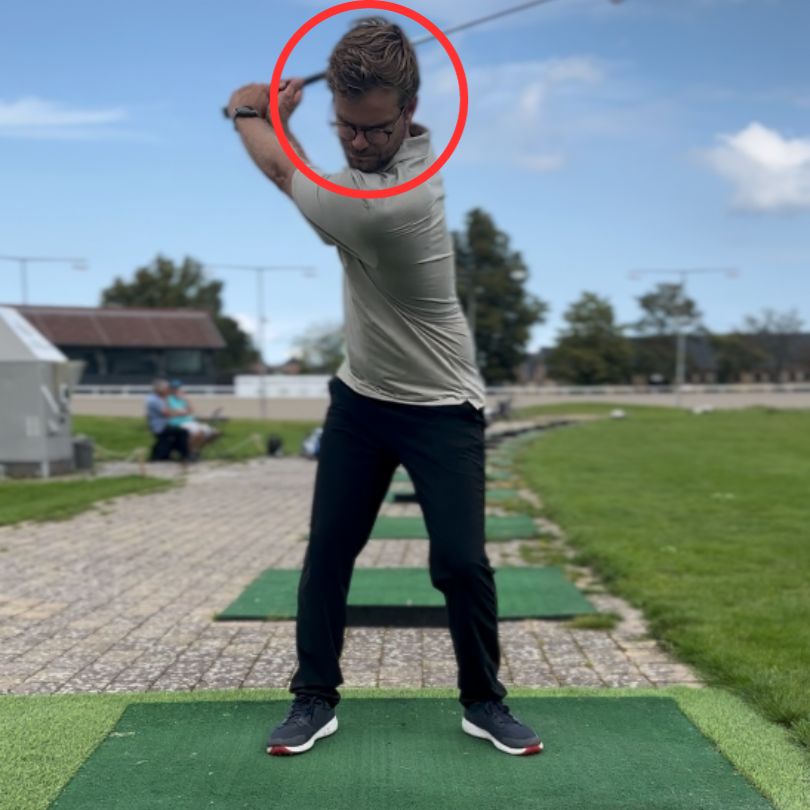
For a video demonstration, check out this video:
4. Keep Left Arm Straight
Maintain a straight left arm during your backswing to promote a wider swing arc. This extension increases the potential for generating power and enhances accuracy. Practice the feeling of keeping your left arm straight during the backswing by incorporating drills that emphasize arm extension and width.
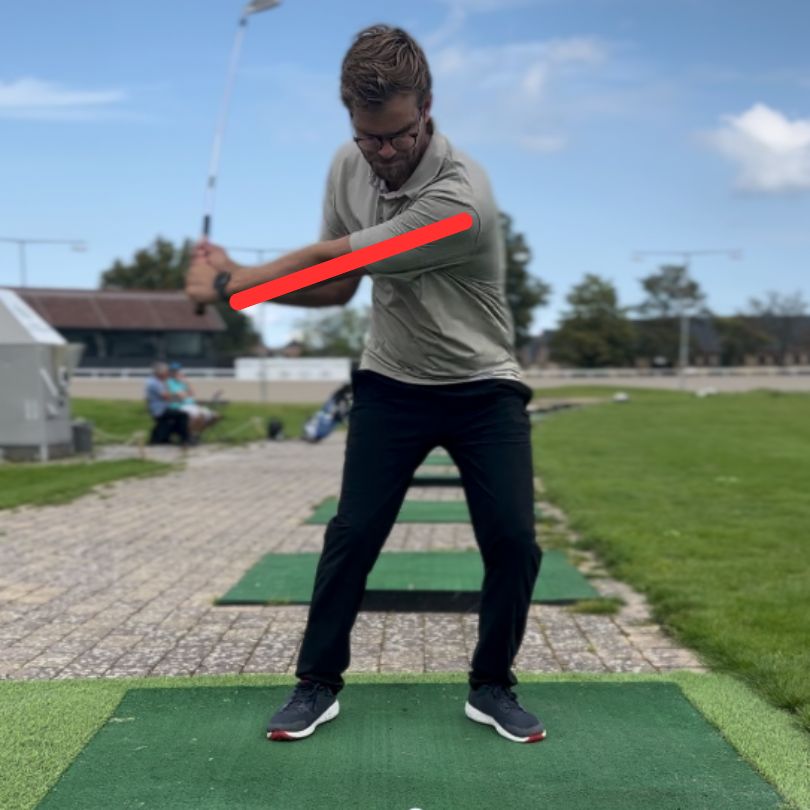
5. Turn Your Hips in the Backswing
Initiate your backswing by turning your hips to set the stage for a full and powerful swing. The hip rotation not only helps create torque but also contributes to a proper weight transfer. Focus on initiating the hip turn early in the backswing to optimize your body’s coil and improve overall swing dynamics.
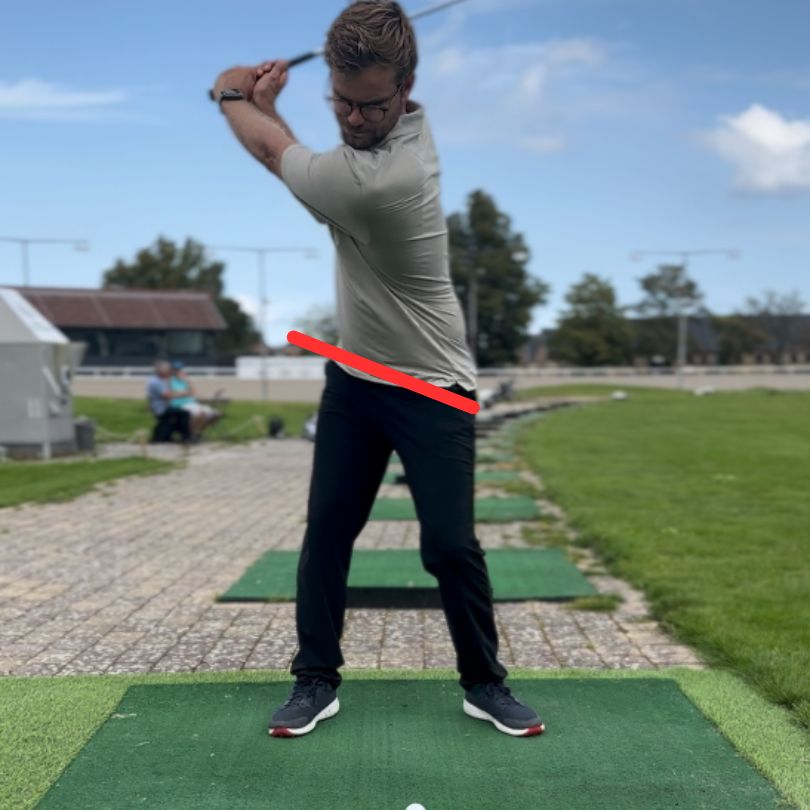
6. Rotate Upper Body with Shoulders Turning Down
To keep your head still, rotate your upper body with shoulders turning down during the backswing. This movement helps maintain a consistent swing plane, preventing the common mistake of lifting the club too steeply. Visualize your upper body rotating around your spine while the shoulders turn downward, creating a more controlled and efficient swing.
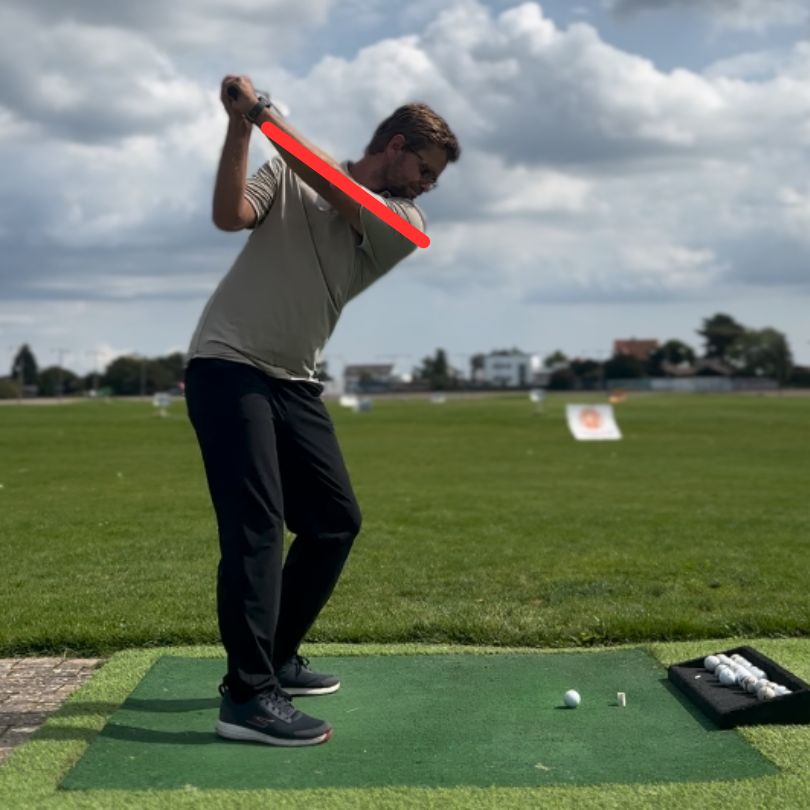
7. Tuck Your Hips in the Follow-Through:
Achieve a balanced and controlled follow-through by tucking your hips. This movement ensures a smooth transition from the downswing to the finish. Practice tucking your hips as you shift your weight onto the lead foot, allowing for a graceful and well-balanced conclusion to your swing.
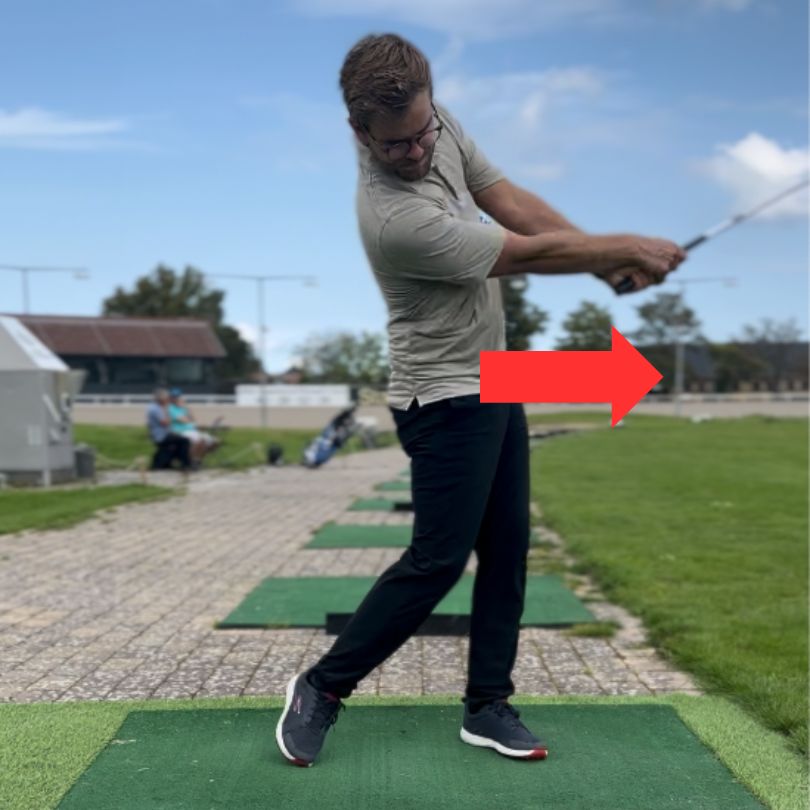
8. Swing Your Hands Around Your Body in a Circle, Not Up:
Optimize your swing path by visualizing a circular motion for your hands, rather than lifting them excessively. This lateral hand movement promotes a more natural and effective swing plane. Imagine your hands tracing a circular path around your body, fostering a smoother and more efficient swing.

9. Keep Both Arms Straight After You've Hit the Ball:
Maintain the extension of both arms post-impact to ensure a consistent follow-through. This extension contributes to overall swing control and helps prevent premature deceleration. Practice extending both arms toward the target after striking the ball, creating a polished and controlled finish.

For another demonstration of this step, check this video and see the difference between pros and amateurs:
10. Extend Body in Finish Position:
Complete your swing with a full extension of your body for a balanced and poised finish. A well-executed finish position reflects control and commitment to the swing. Focus on extending your body toward the target, ensuring that your weight is predominantly on the lead foot and your chest faces the intended target. This extension enhances the overall aesthetics of your swing and reinforces proper mechanics.
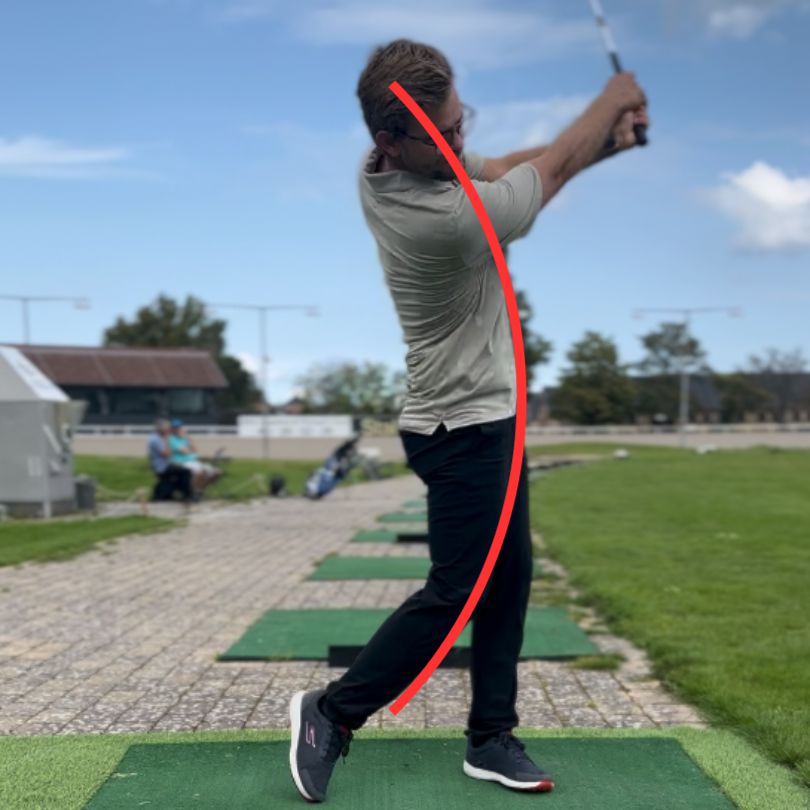
Ready to Take the Next Step? ⛳️
If you’re eager to dive deeper into golf’s intriguing world and master the ins and outs of the game, look no further than our “Golf For Beginners – The Ultimate Starter Guide.” Whether you’re a newbie or just brushing up on your skills, this online course has something for everyone.
⛳️ Discover the Ultimate Golf Starter Guide Right Here ⛳️
Conclusion: Elevate Your Golf Swing as a Beginner
Congratulations! You’ve explored in-depth the top 10 golf swing tips for beginners. Remember, consistency is key in mastering the golf swing. Golf For Beginners Academy is here to support you on your journey to becoming a confident and skilled golfer. Delve into these tips, pay attention to the finer details, and enjoy the improvement in your swing. Happy golfing!

5 Simple Tips on How to Hit a Golf Ball Further
5 Simple Tips on How to Hit a Golf Ball Further
Unleash Your Swing and learn How to Hit a Golf Ball Further
Welcome to Golf For Beginners Academy, where we’re about to unravel the secrets of How to Hit a Golf Ball Farther! Ready to maximizing your distance off the tee. In this guide, we’ll explore five straightforward yet highly effective tips on how to hit a golf ball further. Let’s power up your swing!
1 - Optimize Your Stance for Power
Before you embark on the journey to unlock more power in your golf shots, it’s essential to establish a rock-solid foundation through the optimization of your stance. In this section, we’ll delve into the intricacies of achieving the ideal golf stance, emphasizing balance, weight distribution, and the critical role it plays in generating power and stability in your swing.
The Significance of a Proper Stance: Your golf stance serves as the launchpad for your swing, and its correct configuration is paramount to harnessing maximum power. By optimizing your stance, you set the stage for a dynamic and efficient golf swing. Let’s break down the key elements that contribute to an effective stance.
Shoulder-Width Foundation: Begin by positioning your feet at shoulder width apart. This stance width provides a stable base and balance, ensuring you can maintain control throughout your swing. Visualize your stance as the bedrock upon which your golf swing masterpiece will be built.
Even Weight Distribution: Once you’ve established your shoulder-width foundation, distribute your weight evenly between both feet. Balance is key to a powerful and controlled swing. Avoid favoring one side or the other, as it can lead to instability and inconsistent shots. Think of your stance as a perfectly balanced scale, ready to weigh in on the power equation.
Knee Flexion for Dynamic Power: Slightly flex your knees to add an element of dynamic power to your stance. This knee flexion serves as a coiled spring, ready to release energy during your downswing. Imagine the potential energy stored in your legs, waiting to be converted into clubhead speed and distance.
Spine Tilt for Optimal Alignment: To complete your stance optimization, tilt your spine away from the target ever so slightly. This slight tilt helps align your body correctly and prepares your shoulders for a powerful coil during the backswing. Visualize your spine as the axis around which your swing will rotate, enabling you to generate torque and power.
Stability and Balance: As you adopt this balanced and optimized stance, focus on maintaining stability and balance throughout your swing. Keep your weight centered, your knees flexed, and your spine tilted. These elements work in harmony to provide a stable and powerful foundation for your golf swing.
Practice and Consistency: Achieving a proper stance requires practice and consistency. Spend time at the driving range honing your stance, ensuring it becomes second nature.
In conclusion, optimizing your stance is the foundational step in your journey to unlocking maximum power in your golf shots. Think of it as the canvas upon which you’ll paint your golfing masterpiece. Embrace the principles of shoulder-width foundation, even weight distribution, knee flexion, and spine tilt. With the right stance, you’ll experience a more powerful and stable swing, translating into longer and more controlled shots on the golf course.

2 - Master the Hip Rotation
Achieving maximum distance in your golf shots goes beyond upper body strength; it involves mastering the art of hip rotation. In this section, we will explore the critical role hip engagement plays in transferring energy and increasing clubhead speed, helping you unleash the full potential of your swing.
Understanding the Importance of Hip Rotation: Hip rotation is a fundamental component of generating power in your golf swing. When you initiate your downswing, it’s essential to allow your hips to rotate smoothly. This rotational movement acts as a powerhouse, transferring energy from your lower body to the club. Think of your hips as the engine driving your swing, and mastering this aspect will lead to increased clubhead speed and, consequently, longer shots.
Initiating the Downswing: The proper sequence of your swing involves the hips initiating the downswing. As you transition from the backswing to the downswing, focus on starting the movement with your hips. This rotational action sets the tone for the rest of your swing and ensures that you harness the energy generated by your lower body effectively.
Hip Rotation Dynamics: Effective hip rotation is not about simply turning your hips; it’s about achieving a balanced and synchronized movement. Ensure that your hip rotation is gradual and controlled, avoiding any jerky or forced movements. Visualize a smooth pivot around your spine, allowing your hips to lead the way and follow through seamlessly.
Maintaining Posture and Balance: While emphasizing hip rotation, it’s crucial to maintain proper posture and balance throughout your swing. Keep your spine relatively straight and your weight evenly distributed between your feet. This stability allows you to control the rotational forces generated by your hips and channel them into your clubhead speed. Balance is the key to accuracy and control, which are essential in addition to distance.
The Role of Core Strength: Developing core strength is vital for optimizing hip rotation. A strong core provides stability and control during your swing, allowing you to harness the energy generated by your hips more effectively. Incorporate core-strengthening exercises into your fitness routine to enhance your overall golf performance.
In conclusion, mastering hip rotation is a pivotal aspect of unlocking explosive power in your golf swing. Embrace the concept of your hips as the engine driving your swing’s energy. Practice gradual, controlled hip rotation to ensure a balanced and synchronized movement. With proper hip engagement, you’ll experience increased clubhead speed, leading to longer and more powerful golf shots.

3 - Generate Lag with Wrist Action
Creating and harnessing lag in your golf swing is a secret weapon for adding significant distance to your shots. In this section, we’ll delve into the intricacies of wrist action, teaching you how to generate and maintain lag effectively for a more powerful and controlled downswing.
The Art of Lag Creation: Lag refers to the angle formed between the clubshaft and your lead forearm during the downswing. To generate lag, initiate your swing with a slight wrist hinge during the backswing. This hinge allows you to store energy like a coiled spring, ready to be unleashed for explosive impact. Think of it as winding up before delivering a powerful punch. The key is to maintain this wrist hinge until the last possible moment in your downswing.
Timing is Everything: One of the critical aspects of lag creation is the timing of your wrist release. Delay releasing your wrists until the very last moment before impact. This delayed release is what makes lag such a potent force in your swing. As you transition from the top of your backswing to the downswing, maintain that angle between your clubshaft and forearm, resisting the urge to prematurely release your wrists. Picture it as holding back a loaded slingshot, with the clubhead as your projectile.
Storage and Release of Energy: The beauty of lag lies in its ability to store and release energy explosively. As you maintain the hinge in your wrists, you’re storing potential energy that can be transferred to the golf ball at impact. When you finally release your wrists, that stored energy is unleashed, resulting in faster clubhead speed and greater distance. It’s akin to snapping a whip—a controlled and powerful release that propels the ball down the fairway with added velocity.
Practice and Patience: Developing the skill of generating lag with wrist action requires practice and patience. Start by working on your wrist hinge during your backswing, ensuring it’s gradual and not forced. Progress to your downswing, concentrating on delaying the release. Use practice drills and swing aids to reinforce this skill. It’s essential to strike a balance between generating lag and maintaining control, so practice is key to refining your technique.
Seeking Professional Guidance: For a more in-depth understanding of generating lag, consider seeking guidance from a golf instructor. They can provide personalized feedback, drills, and exercises to help you master this crucial aspect of your swing. Additionally, video analysis can offer valuable insights into your wrist action, enabling you to make necessary adjustments.
In conclusion, generating and maintaining lag with wrist action can significantly enhance your golf swing’s power and distance potential. Embrace the concept of lag as a way to store and release energy explosively at impact. Remember that perfecting this skill takes time and dedication, but the rewards in terms of longer and more controlled shots are well worth the effort.

4 - Perfect Your Timing and Tempo
Mastering the art of hitting a golf ball further goes beyond sheer power; it hinges on achieving the perfect blend of timing and tempo. Let’s dive deep into this crucial aspect of your swing, exploring techniques to help you harness your full potential for longer shots.
The Art of Controlled Tempo: As a beginner, it’s tempting to swing forcefully, believing that raw power alone will send the ball soaring. However, the truth lies in controlling your tempo. Rushing the downswing often leads to inconsistencies and shorter drives. Instead, focus on a smooth, well-timed transition between your backswing and downswing. Imagine a pendulum, swinging back and forth with a balanced rhythm. This analogy reflects the controlled tempo you should aim for in your golf swing.
Balance and Rhythm: Achieving the perfect tempo involves maintaining balance throughout your swing. A proper weight shift from your back foot to your front foot is crucial. Visualize the transfer of your weight, like a graceful dance move, ensuring you maintain your center of gravity and rhythm. This balanced, rhythmic motion is the key to unlocking your optimal clubhead speed, which directly translates into those coveted longer drives.
Mental Game: Your mental approach plays a significant role in mastering timing and tempo. Stay relaxed and focused during your swing, free from any unnecessary tension or anxiety. Practice mindfulness and visualization techniques to enhance your mental game. Visualize the ideal swing in your mind before stepping up to the ball, reinforcing the importance of a controlled and smooth tempo in your subconscious.
Practice and Patience: Achieving a consistent and controlled tempo takes practice and patience. Dedicate time to the driving range to work on your swing mechanics. Consider seeking guidance from a golf instructor to fine-tune your tempo. Understand that it’s a gradual process, and improvements will come with dedication and repetition.
5 - Choose the Right Equipment
The right equipment can be your secret weapon for hitting a golf ball further. Selecting the appropriate gear tailored to your unique swing characteristics is crucial. In this section, we’ll explore the nuances of golf equipment selection and custom fitting, unveiling the key to unlocking your distance potential.
Driver Loft and Shaft Flex: Your driver plays a pivotal role in maximizing distance off the tee. To optimize your drives, ensure your driver has the appropriate loft and shaft flex for your swing speed. A higher loft is ideal for slower swing speeds, as it imparts more backspin and lift on the ball, helping it stay in the air longer. Conversely, if you possess a faster swing speed, a lower loft can help reduce spin for added distance. The shaft flex should match your swing tempo and strength. A more flexible shaft can generate more clubhead speed for those with slower tempos, while a stiffer shaft suits faster swingers. Custom fitting your driver, under the guidance of a professional, can fine-tune these critical aspects to suit your game perfectly.
Club Custom Fitting: Custom fitting is a game-changer when it comes to optimizing your distance potential. It involves tailoring your clubs to match your unique swing characteristics, body posture, and physical attributes. A custom fitting session typically assesses factors such as club length, lie angle, grip size, and more. This meticulous process ensures that each club in your bag complements your swing, resulting in improved accuracy and distance. Many golf retailers and professionals offer custom fitting services, providing you with the opportunity to invest in equipment that truly suits your game.
Ball Selection: Don’t underestimate the role of the golf ball in maximizing your distance. Different golf balls offer varying levels of spin and compression. Consider experimenting with different ball types to find the one that aligns with your swing speed and desired ball flight. A golf ball that matches your game can significantly impact your shot distance and overall performance.
In conclusion, selecting the right equipment and custom fitting your clubs are integral components of hitting a golf ball farther. Pay meticulous attention to your driver’s loft and shaft flex, explore the benefits of club custom fitting, and experiment with different golf balls. By fine-tuning your gear to match your unique characteristics, you’ll unlock your full potential for maximum distance on the golf course.
Want to learn more about how to play golf? ⛳️
If you’re eager to dive deeper into golf’s intriguing world and master the ins and outs of the game, look no further than our “Golf For Beginners – The Ultimate Starter Guide.” Whether you’re a newbie or just brushing up on your skills, this online course has something for everyone.
⛳️ Discover the Ultimate Golf Starter Guide Right Here ⛳️
Conclusion on How to Hit a Golf Ball Further for Beginners
Hitting the ball far can be exhilarating, but is it essential for beginner golfers? While distance is a valuable asset, focus on mastering fundamental techniques first. As your skills grow, incorporate these tips gradually. Remember, accuracy and consistency trump sheer power for beginners. Enjoy the journey of improvement and the occasional long drive will become an added bonus to your game. Stay tuned to Golf For Beginners Academy for more valuable insights to enhance your golfing journey. Happy swinging!
Did you like the article "How to Hit a Golf Ball Further"?
If you want more detailed help with you game of golf, and specifically about the short game of golf, our partner-portal called World Of Short Game deliver great content for all short game related topics. Click here to visit World Of Short Game.
And if you live in Denmark, never hesitated to reach out to Danish Golf Academy for help with any part of your game.
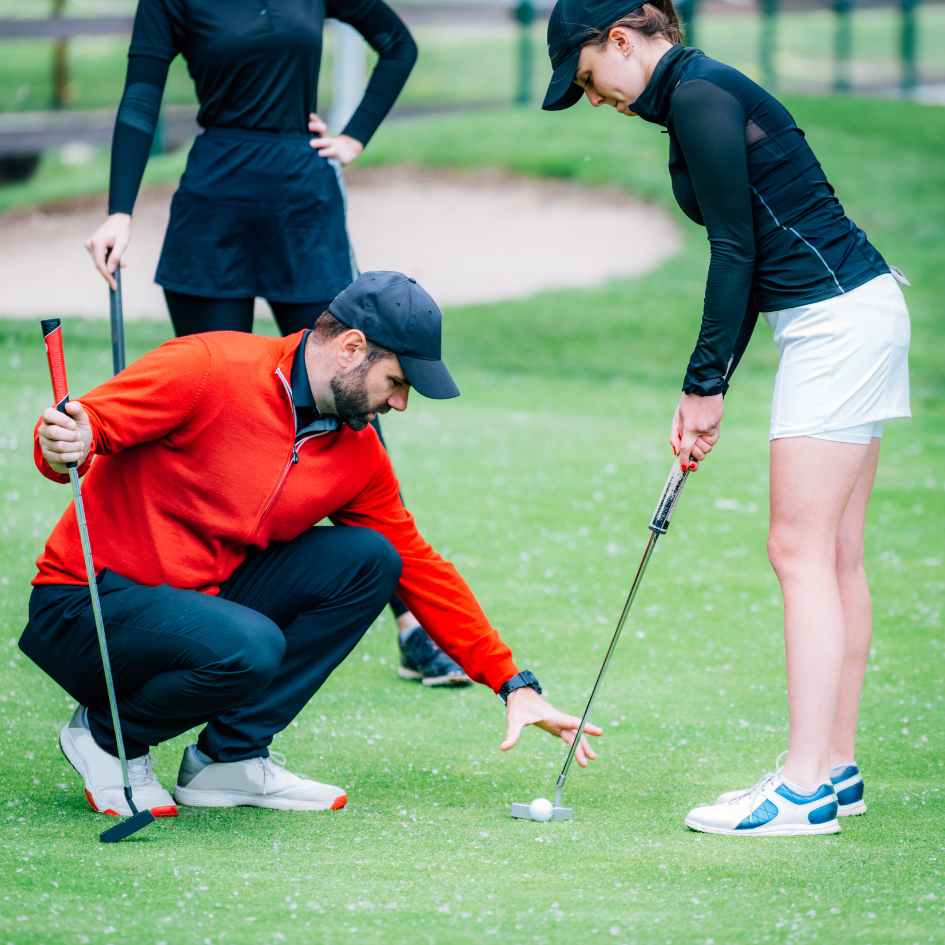
9 Essential Golf Putting Tips for Beginners
9 Essential Golf Putting Tips for Beginners
Perfecting Your Putting as a Beginner
Welcome to Golf For Beginners Academy, where we guide novice players through the basics of golf. Today, we’re focusing on an integral aspect of the game – putting. For beginners, mastering the putt is key to lowering scores and enjoying the game to the fullest. Let’s delve into essential golf putting tips tailored just for you.
Golf Putting Tips for Beginners
Grip and Stance: Start with a comfortable grip, neither too tight nor too loose. Adopt a shoulder-width stance for stability. This sets the foundation for a controlled and consistent putting stroke.
Eye Alignment: Ensure your eyes are directly over the ball. This alignment enhances your perception of the putting line and helps you visualize the correct path to the hole.
Smooth Putting Stroke: Develop a smooth, pendulum-like putting stroke. Avoid unnecessary wrist movements and let the shoulders control the motion. A steady stroke promotes accuracy and distance control.
Distance Control: Mastering distance control is crucial. Spend time practicing putts of various lengths to develop a feel for the required strength. Consistent distance control is a game-changer on the green.
Read the Green: Analyze the slope and break of the green before making your putt. Look for subtle undulations that can influence the ball’s path. Reading the green is a skill that improves with practice and observation.
Practice Putting Drills: Incorporate putting drills into your practice routine. Focus on short putts to build confidence and gradually extend the distance as your skills improve. Consistent practice hones your putting prowess. Check out this article for our favorite putting-drills for beginners!
Putter Choice: Experiment with different putters to find one that feels comfortable for you. The right putter can enhance your control and confidence on the green. Consider seeking advice from a golf professional to find the perfect fit.
Maintain a Routine: Develop a pre-putt routine to create consistency in your setup and stroke. This routine could include a few practice swings, checking the line, and aligning the putter face to your intended target.
Stay Calm Under Pressure: Putting often determines the outcome of a hole. Practice keeping a calm mindset, especially when facing pressure situations. Relax, trust your skills, and execute your stroke with confidence.
Listen to a deeper explanation on our Podcast!
Time to get to work!
Congratulations! You’re now equipped with essential golf putting tips designed specifically for beginners. Put these insights into practice, and watch as your putting skills improve, contributing to a more enjoyable and successful golfing experience. Stay tuned to Golf For Beginners Academy for more valuable tips to enhance your game. Happy putting!
Ready to become a better golfer? ⛳️
You’ve learned about the putting game of golf. If you’re eager to dive deeper into golf’s intriguing world and master the ins and outs of the game, look no further than our “Golf For Beginners – The Ultimate Starter Guide.” Whether you’re a newbie or just brushing up on your skills, this online course has something for everyone.
⛳️ Discover the Ultimate Golf Starter Guide Right Here ⛳️
Did You Like These 9 Essential Golf Putting Tips for Beginners?
If you want more detailed help with you game of golf, and specifically about the short game of golf, our partner-portal called World Of Short Game deliver great content for all short game related topics. Click here to visit World Of Short Game.
And if you live in Denmark, never hesitated to reach out to Danish Golf Academy for help with any part of your game.
Recent Comments
Copyright @ 2024 - Golf For Beginners Academy

